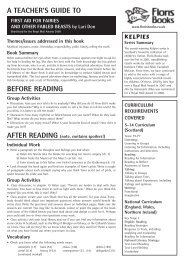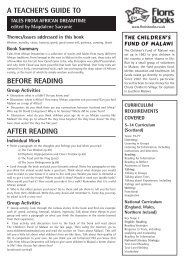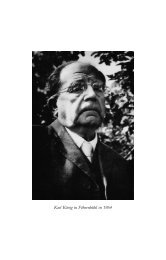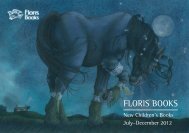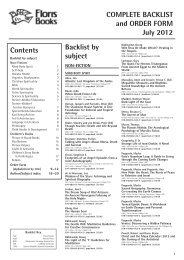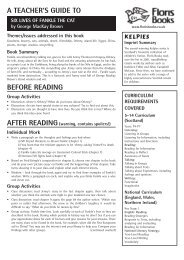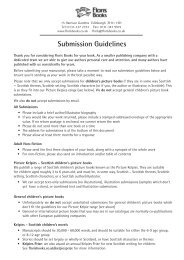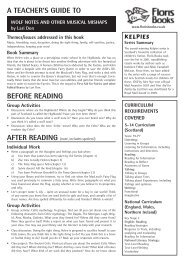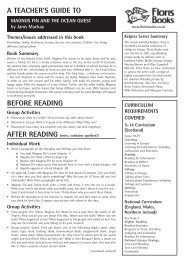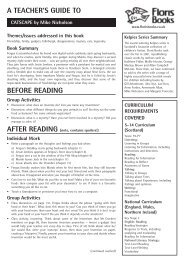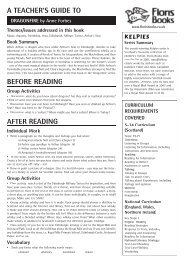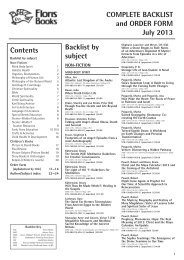Karl König 1962 in New York - Floris Books
Karl König 1962 in New York - Floris Books
Karl König 1962 in New York - Floris Books
You also want an ePaper? Increase the reach of your titles
YUMPU automatically turns print PDFs into web optimized ePapers that Google loves.
<strong>Karl</strong> <strong>König</strong> <strong>1962</strong> <strong>in</strong> <strong>New</strong> <strong>York</strong><br />
KKA09-Communities.<strong>in</strong>dd 2 6/2/2011 10:37:55 AM
Communities<br />
for Tomorrow<br />
Edited by Richard Steel<br />
<strong>Floris</strong> <strong>Books</strong><br />
KKA09-Communities.<strong>in</strong>dd 3 6/2/2011 10:37:55 AM
<strong>Karl</strong> <strong>König</strong> Archive, Vol. 9<br />
Subject: The Camphill movement<br />
<strong>Karl</strong> <strong>König</strong>’s collected works are issued by<br />
the <strong>Karl</strong> <strong>König</strong> Archive, Aberdeen<br />
<strong>in</strong> co-operation with the Ita Wegman Institute<br />
for Basic Research <strong>in</strong>to Anthroposophy, Arlesheim<br />
First published <strong>in</strong> German <strong>in</strong> 2010 under the title<br />
Geme<strong>in</strong>schaftsbuldung im Lichte Michaels by Verlag am Goetheanum<br />
First published <strong>in</strong> English by <strong>Floris</strong> <strong>Books</strong> <strong>in</strong> 2011<br />
The orig<strong>in</strong>al German text of Sergei Prokofieff’s lecture, ‘The Nathan Soul’s<br />
Task for Humanity’ was edited by Ute Fischer, and translated by Marguerite<br />
and Douglas Miller. Peter Selg’s ‘The Dest<strong>in</strong>y of <strong>Karl</strong> <strong>König</strong>’ and Bodo von<br />
Plato’s ‘<strong>Karl</strong> <strong>König</strong> and the Spirit of our Time’ were translated by Helen Lub<strong>in</strong>.<br />
© 2011 Trustees of the <strong>Karl</strong> <strong>König</strong> Archive<br />
All rights reserved. No part of this publication may<br />
be reproduced without the prior permission of<br />
<strong>Floris</strong> <strong>Books</strong>, 15 Harrison Gardens, Ed<strong>in</strong>burgh<br />
www.florisbooks.co.uk<br />
British Library CIP Data available<br />
ISBN 978-086315-810-0<br />
Pr<strong>in</strong>ted <strong>in</strong> Great Brita<strong>in</strong><br />
by CPI Antony Rowe, Chippenham<br />
KKA09-Communities.<strong>in</strong>dd 4 6/2/2011 10:37:55 AM
Contents<br />
Foreword by Cornelius Pietzner 9<br />
The Meet<strong>in</strong>g of Traditional and <strong>New</strong> Impulses<br />
<strong>in</strong> Community by Virg<strong>in</strong>ia Sease 11<br />
Community Build<strong>in</strong>g as Practice through the ‘I’<br />
by Penelope Roberts-Bar<strong>in</strong>g 16<br />
The Nathan Soul’s Task for Humanity<br />
by Sergei O. Prokofieff 23<br />
The Dest<strong>in</strong>y of <strong>Karl</strong> <strong>König</strong> by Peter Selg 51<br />
<strong>Karl</strong> <strong>König</strong> and the Spirit of our Time<br />
by Bodo von Plato 66<br />
Social Formation and Community Build<strong>in</strong>g<br />
for Tomorrow by Cornelius Pietzner 77<br />
Clarity, Heartfelt Knowledge and Will<strong>in</strong>g the Future:<br />
An Introduction to Carlo Pietzner’s Kaspar Hauser Play<br />
by Richard Steel 87<br />
KKA09-Communities.<strong>in</strong>dd 5 6/2/2011 10:37:55 AM<br />
5
And from the Night, Kaspar by Carlo Pietzner 94<br />
The Mysteries of the Will: An Introduction<br />
to the Michaelmas Play by Richard Steel 129<br />
A Play for Michaelmas by <strong>Karl</strong> <strong>König</strong> 136<br />
Notes 149<br />
Bibliography 153<br />
Index 155<br />
6<br />
KKA09-Communities.<strong>in</strong>dd 6 6/2/2011 10:37:55 AM
A state and society that see themselves as ends <strong>in</strong> themselves<br />
must strive to have command over the <strong>in</strong>dividual,<br />
however this dom<strong>in</strong>ation may look; whether it is absolutist,<br />
constitutional or republican. If the state no longer<br />
were to see itself as an end <strong>in</strong> itself but as an <strong>in</strong>strument,<br />
then it would no longer assert its pr<strong>in</strong>ciple of dom<strong>in</strong>ation.<br />
It would organize itself so that each <strong>in</strong>dividual obta<strong>in</strong>ed<br />
his optimal validity. Its ideal would be non-governance.<br />
It would be a community that expected noth<strong>in</strong>g for itself<br />
but everyth<strong>in</strong>g for the <strong>in</strong>dividual.<br />
The ma<strong>in</strong> sociological law, Rudolf Ste<strong>in</strong>er, 1898 1<br />
If people today could come to a decision <strong>in</strong> a dignified<br />
way to <strong>in</strong>itiate a Michaelmas Festival at the end of<br />
September, it would be a deed of great significance. For<br />
this courage would be needed, not only to discuss the<br />
outer organization of social life, but to do someth<strong>in</strong>g that<br />
would reconnect the earth with the heavens. And because<br />
then the spirit world would be <strong>in</strong>cluded aga<strong>in</strong> <strong>in</strong> earthly<br />
proceed<strong>in</strong>gs, thus someth<strong>in</strong>g would take place amongst<br />
human be<strong>in</strong>gs that would be a mighty impulse for the<br />
cont<strong>in</strong>uation of our civilization and of our whole life.<br />
Rudolf Ste<strong>in</strong>er 2<br />
KKA09-Communities.<strong>in</strong>dd 7 6/2/2011 10:37:55 AM
KKA09-Communities.<strong>in</strong>dd 8 6/2/2011 10:37:55 AM
Foreword<br />
For the Michaelmas Conference 2009, the Executive Council at<br />
the Goetheanum elected to host a conference with the theme<br />
Community Build<strong>in</strong>g <strong>in</strong> the light of Michael together with the Camphill<br />
community. Over the last seven years the Executive Council met<br />
annually with members of the Focus Group of Camphill to exam<strong>in</strong>e<br />
and discuss the esoteric background and present situation of<br />
both the Camphill community and the General Anthroposophical<br />
Society. The conference and its theme represented a further deepen<strong>in</strong>g<br />
of this common work, and a decision to turn to an area of<br />
central significance not only for the General Anthroposophical<br />
Society and Camphill, but <strong>in</strong>creas<strong>in</strong>gly for all those wish<strong>in</strong>g to<br />
engage and connect themselves with a deeper understand<strong>in</strong>g of<br />
community build<strong>in</strong>g today.<br />
It was the aim of this Michaelmas conference to exam<strong>in</strong>e<br />
aspects of community build<strong>in</strong>g from an anthroposophical orientation<br />
and <strong>in</strong> relation to the work of Camphill and its underly<strong>in</strong>g<br />
spiritual impulses, formulated to a large extent by <strong>Karl</strong> <strong>König</strong>,<br />
and place these <strong>in</strong> the context of the spirit of our age. This small<br />
volume makes available the lectures held dur<strong>in</strong>g the conference<br />
which address specific aspects of community build<strong>in</strong>g, focus on<br />
Dr <strong>König</strong> as a pioneer of the Camphill community and its attempt<br />
to create community <strong>in</strong> sett<strong>in</strong>gs all over the world, and turn to<br />
some of the spiritual streams that work directly <strong>in</strong>to community<br />
life, both per se and <strong>in</strong> specific regard to Camphill. Further, we<br />
<strong>in</strong>clude two plays that were performed dur<strong>in</strong>g the conference, And<br />
KKA09-Communities.<strong>in</strong>dd 9 6/2/2011 10:37:55 AM<br />
9
10<br />
C O M M u N i T i e S f O R T O M O R R O w<br />
from the Night, concern<strong>in</strong>g Kaspar Hauser by Carlo Pietzner, and<br />
the Michaelmas Play written by Dr <strong>König</strong>. The latter po<strong>in</strong>ts to central<br />
aspects of the development of a new and grow<strong>in</strong>g <strong>in</strong>dividual<br />
relationship to the mystery wisdom hitherto exclusively held <strong>in</strong><br />
the temples while the former play depicts the rediscovery and confirmation<br />
of life tasks and moral orientation of a group of younger<br />
colleagues aga<strong>in</strong>st the background of one of the most remarkable<br />
human dest<strong>in</strong>ies <strong>in</strong> Europe <strong>in</strong> the last two hundred years.<br />
The human be<strong>in</strong>g consolidates and expresses identity through<br />
<strong>in</strong>dividual <strong>in</strong>itiative and work. The <strong>in</strong>itiatives and activity that we<br />
unfold not only form a script <strong>in</strong>timately connected to our <strong>in</strong>dividual<br />
biography and dest<strong>in</strong>y, but do so <strong>in</strong> a context that <strong>in</strong>variably<br />
will <strong>in</strong>clude and affect other people, either directly or <strong>in</strong>directly.<br />
Unfold<strong>in</strong>g such activity <strong>in</strong> conscious relationship with others draws<br />
us <strong>in</strong>to a community nexus that activates human and spiritual forces<br />
as a help and source of strength and affirmation. It requires both<br />
<strong>in</strong>sight and recognition of several spiritual operat<strong>in</strong>g pr<strong>in</strong>ciples so to<br />
speak, that reflect hidden but powerful and challeng<strong>in</strong>g laws.<br />
Indeed, recognition of these pr<strong>in</strong>ciples and spiritual attributes<br />
deepens and vitalizes the difficult but <strong>in</strong>creas<strong>in</strong>gly necessary <strong>in</strong>ner<br />
dimension of build<strong>in</strong>g community. Rudolf Ste<strong>in</strong>er has offered<br />
diverse, profound and last<strong>in</strong>g <strong>in</strong>sights <strong>in</strong>to this subtle but core aspect<br />
of social life. Camphill, with over seventy years attempt<strong>in</strong>g to create<br />
a liv<strong>in</strong>g community alchemy drawn from different aspects conta<strong>in</strong>ed<br />
with<strong>in</strong> anthroposophy and comb<strong>in</strong>ed with a clear and compell<strong>in</strong>g<br />
social mission, offers important complementary experiences to any<br />
serious discussion of community build<strong>in</strong>g <strong>in</strong> the light of Michael.<br />
This volume is an expression of both empirical research and<br />
work <strong>in</strong> progress, and <strong>in</strong> this sense is a modest contribution to<br />
the community build<strong>in</strong>g <strong>in</strong>itiatives of so many <strong>in</strong>dividuals and<br />
groups worldwide actively seek<strong>in</strong>g to weave mean<strong>in</strong>gful <strong>in</strong>dividual<br />
striv<strong>in</strong>g <strong>in</strong>to the larger fabric of social life.<br />
Cornelius Pietzner<br />
Dornach, 2010<br />
KKA09-Communities.<strong>in</strong>dd 10 6/2/2011 10:37:55 AM
The Meet<strong>in</strong>g of<br />
Traditional and <strong>New</strong> Impulses<br />
<strong>in</strong> Community<br />
Virg<strong>in</strong>ia Sease<br />
We may be aware of the situation that all development beg<strong>in</strong>s<br />
from a po<strong>in</strong>t, and then will spread out <strong>in</strong>to manifoldness. We<br />
th<strong>in</strong>k even of the very first moment <strong>in</strong> the development of a<br />
human be<strong>in</strong>g <strong>in</strong> the mother’s organism which also develops from<br />
a po<strong>in</strong>t. When we look back <strong>in</strong>to previous ages, from time immemorial,<br />
the pr<strong>in</strong>ciple of the po<strong>in</strong>t was the pr<strong>in</strong>ciple <strong>in</strong> which<br />
people lived. The po<strong>in</strong>t was the commonality, the sameness, the<br />
experience of the cohesiveness of community such as the family,<br />
the nation, the race, the folk and the language <strong>in</strong>to which<br />
the <strong>in</strong>dividual was born. This gave security to people <strong>in</strong> ancient<br />
times. The <strong>in</strong>ner soul stability depended on this cohesiveness of<br />
commonality.<br />
This is also an <strong>in</strong>credible force <strong>in</strong> humanity today. We know<br />
that when we encounter a person who is radically different from<br />
ourselves that we have to make a transfer from our soul-level of<br />
understand<strong>in</strong>g which would be adequate for somebody similar<br />
to ourselves, to an engagement of our I-nature. And this transfer<br />
from a soul response to the possibility of an ego or an I response<br />
KKA09-Communities.<strong>in</strong>dd 11 6/2/2011 10:37:55 AM<br />
11
12<br />
C O M M u N i T i e S f O R T O M O R R O w<br />
belongs very much to the entire human situation of today as<br />
we are liv<strong>in</strong>g under the aegis of the great time spirit, Michael.<br />
Nevertheless, the shackles of the Gabrielic Age still cl<strong>in</strong>g to us<br />
especially <strong>in</strong> regard to community. There is, however, a specific<br />
law connected with this transfer from one guid<strong>in</strong>g great spiritual<br />
be<strong>in</strong>g over <strong>in</strong>to the next period of development for humanity.<br />
When we th<strong>in</strong>k that the leadership of an archangel cont<strong>in</strong>ues<br />
usually for about three to four hundred years, we must also<br />
reckon with the fact that the previous age projects <strong>in</strong>to the next<br />
age and exerts an <strong>in</strong>fluence. The Gabrielic age extended from<br />
1510 to 1879, accord<strong>in</strong>g to Rudolf Ste<strong>in</strong>er, but it still exerted an<br />
<strong>in</strong>fluence for about a hundred years until approximately 1979.<br />
Dur<strong>in</strong>g this time, <strong>in</strong> the civilized world, we see the development<br />
of science and also significant geographic discoveries. But simultaneously<br />
<strong>in</strong> a very <strong>in</strong>ner sphere, the beg<strong>in</strong>n<strong>in</strong>g of the development<br />
of an <strong>in</strong>ternal organ with<strong>in</strong> the bra<strong>in</strong> commenced, which<br />
with its development eventually will allow us to understand and<br />
to see the riddles and the mysteries connected with karma. That<br />
is someth<strong>in</strong>g which is <strong>in</strong> the future, but its germ<strong>in</strong>al moment<br />
began <strong>in</strong> the Gabrielic age. Then we will understand the great<br />
differences between human be<strong>in</strong>gs.<br />
When we reflect further about the situation <strong>in</strong> which we<br />
are today from the po<strong>in</strong>t of view of community, then we realize,<br />
thanks to Rudolf Ste<strong>in</strong>er, that also Michael changed <strong>in</strong> his<br />
configuration regard<strong>in</strong>g his task. At the time of the Mystery of<br />
Golgotha, Michael became fully the countenance of the Christbe<strong>in</strong>g.<br />
Thus the sun — the Christ-be<strong>in</strong>g — who sh<strong>in</strong>es on<br />
everyone can also stream through Michael. So today we have<br />
a situation of cosmopolitanism, or pictorially speak<strong>in</strong>g the sun<br />
sh<strong>in</strong><strong>in</strong>g forth from Michael and from the Christ-be<strong>in</strong>g throughout<br />
all of humanity regardless of what people may th<strong>in</strong>k they<br />
know or believe. This proves to be an <strong>in</strong>creased possibility for<br />
human awareness.<br />
We notice, however, that this cosmopolitan quality of the<br />
Michael Age manifests, first of all, <strong>in</strong> a rather distorted, dis-<br />
KKA09-Communities.<strong>in</strong>dd 12 6/2/2011 10:37:55 AM
V i R G i N i A S e A S e – T R A d i T i O N A L A N d N e w i M P u L S e S<br />
figured appearance. That often happens with qualities which<br />
will become significant <strong>in</strong> the future; they appear <strong>in</strong>itially <strong>in</strong> a<br />
distorted manner. So surely today, we have cosmopolitanism,<br />
but it is more related to the necessities of different peoples and<br />
nations who still feel themselves bound together <strong>in</strong> their national<br />
configuration, <strong>in</strong> their religious adherence, and so on, but seek<br />
broader contact with the world <strong>in</strong> regard to the natural resources<br />
of the earth, such as oil, gra<strong>in</strong>s and so forth. People feel very protective<br />
of all that belongs to the physical side of life. This represents<br />
the carry-over still from the past, and yet already, although<br />
it is not yet a free deed, more and more people realize and have<br />
expressed the fact that humanity has qualities which belong to<br />
every human be<strong>in</strong>g. The ideal of one earth for all people lives significantly<br />
stronger than it did even a half a century ago. I mention<br />
this because sometimes we feel rather discouraged perhaps that<br />
we may not be mak<strong>in</strong>g progress <strong>in</strong> this Michaelic age; however,<br />
the seeds of progress are there, and the question will be whether<br />
they will be able to develop <strong>in</strong>to fruition with<strong>in</strong> the next decade<br />
or even the next century. That possibility will depend very much<br />
on whether free deeds can be accomplished not just from groups<br />
of people but first of all from each <strong>in</strong>dividual. This will be the<br />
start<strong>in</strong>g po<strong>in</strong>t, that is the s<strong>in</strong>gle po<strong>in</strong>t, and it is just as necessary<br />
<strong>in</strong> society that this s<strong>in</strong>gle po<strong>in</strong>t provides the start<strong>in</strong>g-off po<strong>in</strong>t as<br />
it is with the development of the human be<strong>in</strong>g with<strong>in</strong> the body<br />
of the mother. A s<strong>in</strong>gle po<strong>in</strong>t which can expand rests on the same<br />
law as does a s<strong>in</strong>gle human be<strong>in</strong>g who enters <strong>in</strong>to responsibility<br />
for community and for cosmopolitanism.<br />
It will depend on a purposeful <strong>in</strong>itiative of each human be<strong>in</strong>g<br />
which will be ignited and will be enhanced through human<br />
awareness. Community is the basic manner of be<strong>in</strong>g able to realize<br />
such a goal. I will call this the awaken<strong>in</strong>g out of purposeful<br />
directed <strong>in</strong>itiative to the separate unique <strong>in</strong>dividual and the will<br />
to unite the <strong>in</strong>dividual uniqueness of one human be<strong>in</strong>g with<br />
another <strong>in</strong> a community of life not fettered by the ties of the<br />
Gabriel Age and transcend<strong>in</strong>g the distortions of the present time.<br />
KKA09-Communities.<strong>in</strong>dd 13 6/2/2011 10:37:55 AM<br />
13
14<br />
C O M M u N i T i e S f O R T O M O R R O w<br />
In the meet<strong>in</strong>g of traditional and new impulses <strong>in</strong> any sphere<br />
— not only <strong>in</strong> community build<strong>in</strong>g — there exist great polarities<br />
<strong>in</strong> regard to expression: radical annihilation of the old (revolution)<br />
and transformation (metamorphosis). The strange aspect<br />
of revolution is that it can be <strong>in</strong> some cases very productive. But,<br />
if we do look at revolutions from the twentieth century with<strong>in</strong><br />
great national, racial or religious contexts, and we have many<br />
examples, big and small, the remarkable th<strong>in</strong>g is that often <strong>in</strong><br />
just one generation or so the old ways, the old limitations, the<br />
old prejudices beg<strong>in</strong> to creep back <strong>in</strong>to the successors <strong>in</strong> the follow<strong>in</strong>g<br />
generation. We see this especially <strong>in</strong> the return of certa<strong>in</strong><br />
forms of totalitarianism.<br />
It is different with transformation, which is a longer but safer<br />
path because the beg<strong>in</strong>n<strong>in</strong>g step for transformation is to recognize<br />
the necessity to l<strong>in</strong>k on, to connect with what was formed<br />
positively before, and then from that po<strong>in</strong>t to proceed forward.<br />
One could th<strong>in</strong>k perhaps that is not so <strong>in</strong>terest<strong>in</strong>g or excit<strong>in</strong>g, but<br />
all of us know that a coat which is totally worn-out, threadbare<br />
and has many holes <strong>in</strong> it is much better on a cold day than no<br />
coat at all. So the connect<strong>in</strong>g-on to the old can be helpful as long<br />
as one is <strong>in</strong>wardly prepared to discard what is obsolete and what<br />
has already fulfilled its purpose.<br />
The supreme example of will<strong>in</strong>gness and ability at the right<br />
moment to discard that which had fulfilled its purpose meets us<br />
when we have before our souls the mighty reality of the Christbe<strong>in</strong>g<br />
on the cross. He prayed to the Father that he would be able<br />
to go through the last moments before discard<strong>in</strong>g his very holy<br />
vessel <strong>in</strong> which he had lived, so that at the right time his spirit<br />
would be able to transcend, would be able to resurrect, signify<strong>in</strong>g<br />
the victory over his cosmic and earthly dest<strong>in</strong>y. This may serve<br />
as the ultimate pr<strong>in</strong>ciple of transformation: recogniz<strong>in</strong>g the right<br />
moment and thereby fulfill<strong>in</strong>g the great purpose of <strong>in</strong>dividuality<br />
and humanity as well as cosmic progression.<br />
In regard to community today, to our possibility of a cohesiveness<br />
with our fellow human be<strong>in</strong>gs, there are special words<br />
KKA09-Communities.<strong>in</strong>dd 14 6/2/2011 10:37:55 AM
V i R G i N i A S e A S e – T R A d i T i O N A L A N d N e w i M P u L S e S<br />
which Rudolf Ste<strong>in</strong>er spoke, and many of you know these words.<br />
I feel that they could be for us dur<strong>in</strong>g these next days, someth<strong>in</strong>g<br />
which we could carry <strong>in</strong> our souls. We have people here from<br />
various walks of life, from many different professions. Most<br />
came completely <strong>in</strong>dependently, but other people are here only<br />
because very good and car<strong>in</strong>g friends brought them here, wanted<br />
them to be part of this important meet<strong>in</strong>g.<br />
So we may th<strong>in</strong>k of the words which Rudolf Ste<strong>in</strong>er brought<br />
which will conclude this short presentation. Rudolf Ste<strong>in</strong>er tells<br />
us how an underly<strong>in</strong>g new impulse will enliven our experience<br />
of community with other human be<strong>in</strong>gs today.<br />
[Christ] said: ‘Inasmuch as ye have done it unto one of<br />
the least of these my brethren ye have done it unto me.’<br />
The Christ will not stop reveal<strong>in</strong>g himself to human<br />
be<strong>in</strong>gs to the end of earthly time. And this is what he<br />
is say<strong>in</strong>g today to those people will<strong>in</strong>g to hear him: In<br />
whatever the least of your brethren th<strong>in</strong>ks, you must<br />
recognize that I am th<strong>in</strong>k<strong>in</strong>g <strong>in</strong> him, and that I am feel<strong>in</strong>g<br />
with both of you when you br<strong>in</strong>g the other’s thoughts<br />
<strong>in</strong>to relation with your own, and take a social <strong>in</strong>terest <strong>in</strong><br />
what is tak<strong>in</strong>g place <strong>in</strong> the other person’s soul. Whatever<br />
you f<strong>in</strong>d when you discover the op<strong>in</strong>ion or world<br />
outlook of one of the least of your brethren, you are<br />
seek<strong>in</strong>g me.<br />
This is how the Christ is speak<strong>in</strong>g to our life of<br />
thought now, for s<strong>in</strong>ce the beg<strong>in</strong>n<strong>in</strong>g of the the twentieth<br />
century he has been reveal<strong>in</strong>g himself to human be<strong>in</strong>gs<br />
<strong>in</strong> a new way. 1<br />
This conference may afford us the possibility to live <strong>in</strong>to these<br />
words of the Christ-be<strong>in</strong>g for our time.<br />
KKA09-Communities.<strong>in</strong>dd 15 6/2/2011 10:37:55 AM<br />
15
16<br />
Community Build<strong>in</strong>g as<br />
Practice Through the ‘I’<br />
Penelope Roberts-Bar<strong>in</strong>g<br />
Why do we celebrate Michaelmas with the theme of community<br />
build<strong>in</strong>g? Why do the hearts of so many who call themselves<br />
anthroposophists resound to the ideal of community? We have<br />
heard from Rudolf Ste<strong>in</strong>er that we have been united <strong>in</strong> a supersensible<br />
school around Michael, with Michael as our teacher.<br />
With this <strong>in</strong> m<strong>in</strong>d we can be full of joy and expectation when we<br />
first encounter other anthroposophists, feel<strong>in</strong>g that we should<br />
‘know them,’ that they are our karmic group. But how do we<br />
make this connection real on the earthly plane? There are blocks.<br />
Language is a block. Age differences can be a block <strong>in</strong> some cases.<br />
There is also the simple fact that we are attracted to some people<br />
with whom we engage and embark on life-projects whilst others<br />
go <strong>in</strong> different directions with other groups. We are faced with<br />
the fact that <strong>in</strong> the Anthroposophical Society, although Michael<br />
<strong>in</strong>spires us all and <strong>in</strong> that sense we belong together, there are difficulties<br />
<strong>in</strong> experienc<strong>in</strong>g community. On the one hand we have a<br />
l<strong>in</strong>ger<strong>in</strong>g memory of community with Michael; on the other we<br />
can be frustrated, f<strong>in</strong>d<strong>in</strong>g it very hard to achieve.<br />
Before birth we were <strong>in</strong> a spiritual condition <strong>in</strong>terpenetrated<br />
with other be<strong>in</strong>gs. We experienced union with others. Hence<br />
KKA09-Communities.<strong>in</strong>dd 16 6/2/2011 10:37:55 AM
P e N e L O P e R O B e R T S - B A R i N G – C O M M u N i T Y B u i L d i N G<br />
youth comes to earth expect<strong>in</strong>g community. Youth carries a<br />
certa<strong>in</strong> hope, certa<strong>in</strong> <strong>in</strong>nocence with it. It is only with experience<br />
and time that another k<strong>in</strong>d of understand<strong>in</strong>g emerges and<br />
we realize that this ideal of community, this effort at community<br />
is actually a path. Ultimately this path can be terrify<strong>in</strong>g. Even<br />
when stand<strong>in</strong>g face to face with one other human be<strong>in</strong>g we may<br />
experience a k<strong>in</strong>d of <strong>in</strong>ner dy<strong>in</strong>g: a fear that they may really see<br />
us, a shame that we won’t be good enough or even anger when<br />
they oppose us. It is not easy to meet ‘from I to I’ <strong>in</strong> freedom and<br />
with equanimity. We can be confronted with everyth<strong>in</strong>g that is<br />
not yet pure <strong>in</strong> us.<br />
Many who have tried to work with others <strong>in</strong> a Society branch<br />
meet<strong>in</strong>g, a teachers’ college or a community like Camphill have<br />
met this struggle. It can be summarized very simply: Community<br />
depends on learn<strong>in</strong>g to love the other. It is a matter of the heart.<br />
To achieve community truly, the heart has to open to the other<br />
and to do this purely the heart must break open. The heart has<br />
to struggle. The heart has to meet its shadow. The heart has to<br />
acknowledge its egoism. Then this heart becomes an offer<strong>in</strong>g.<br />
This is community build<strong>in</strong>g as practice through the i. What is the ‘I’?<br />
In India the holiest sound is Om (Aum). What does this mean?<br />
These ancient sounds, Aum or Om mean: the I that has been, that<br />
now is and that is to come, <strong>in</strong> other words the eternally becom<strong>in</strong>g<br />
I. The I or ego is not yet fully there. It is becom<strong>in</strong>g. This has<br />
to do with community.<br />
Stand<strong>in</strong>g <strong>in</strong> the Great Hall of the Goetheanum or sitt<strong>in</strong>g <strong>in</strong><br />
a particular seat, we can experience be<strong>in</strong>g at a cross<strong>in</strong>g po<strong>in</strong>t<br />
between heaven and earth. More than that, we are a meet<strong>in</strong>g<br />
po<strong>in</strong>t between past and future, between elemental spirits and the<br />
hierarchies, between Ahriman and Lucifer, between life before<br />
and birth and life after death, the temple of man and the goddess<br />
Natura. All of this is <strong>in</strong>scribed <strong>in</strong> the pillars, on the ceil<strong>in</strong>g, <strong>in</strong><br />
the coloured w<strong>in</strong>dows. Stand<strong>in</strong>g <strong>in</strong> the Great Hall we are with<strong>in</strong><br />
our universal humanity, made visible around us. We can become<br />
aware of all the deeds and activities of be<strong>in</strong>gs, which have offered<br />
KKA09-Communities.<strong>in</strong>dd 17 6/2/2011 10:37:55 AM<br />
17
18<br />
C O M M u N i T i e S f O R T O M O R R O w<br />
themselves for our human evolution. We are the outcome of all<br />
these offer<strong>in</strong>gs and sacrifices throughout cosmic history. With<strong>in</strong><br />
this build<strong>in</strong>g we are surrounded with this. Each of us <strong>in</strong> our s<strong>in</strong>gle<br />
humanity fits with<strong>in</strong> it, now and always. But we are not alone.<br />
There are others stand<strong>in</strong>g <strong>in</strong> front and beh<strong>in</strong>d, to the left and to<br />
the right. What about them?<br />
In our present time we have what Rudolf Ste<strong>in</strong>er called the<br />
baby with<strong>in</strong> us: our I, our ich. It is our youngest part, as yet<br />
only beg<strong>in</strong>n<strong>in</strong>g to establish itself with<strong>in</strong> us. Because of that very<br />
young condition this I is sometimes not so wise. Sometimes it<br />
becomes <strong>in</strong>secure and confused and tries to create security by<br />
pull<strong>in</strong>g th<strong>in</strong>gs to it. These can be as mundane as chocolate or as<br />
compell<strong>in</strong>g as another person or a job. This is all true and correct<br />
because we do feel related to those th<strong>in</strong>gs. They lead us to our<br />
unfold<strong>in</strong>g dest<strong>in</strong>y. They pull us forward <strong>in</strong>to activities <strong>in</strong> life and<br />
<strong>in</strong>scribe us <strong>in</strong>to the earth.<br />
However, when we move forward <strong>in</strong>to our dest<strong>in</strong>y, the<br />
trouble beg<strong>in</strong>s. It is very hard to forge one’s dest<strong>in</strong>y without<br />
do<strong>in</strong>g harm to others, consciously or mostly unconsciously. It<br />
is impossible to avoid. Even if we try we can fall <strong>in</strong>to the trap of<br />
tak<strong>in</strong>g oneself too seriously, under the illusion that we can be<br />
perfect.<br />
Peter Roth, a founder of Camphill and a priest of the Christian<br />
Community, once spoke about sacrifice. He said that the most<br />
important deed <strong>in</strong> relation to Michael was to make an offer<strong>in</strong>g<br />
of one’s dest<strong>in</strong>y. One could learn to step aside from one’s dest<strong>in</strong>y,<br />
take hold of it <strong>in</strong> such a way as to make it a tool for what is<br />
needed <strong>in</strong> the world. If my temperament is a burden to others,<br />
then it is my responsibility to transform it. If I run <strong>in</strong>to problems<br />
with somebody and th<strong>in</strong>k I am <strong>in</strong> the right and they are wrong,<br />
the important th<strong>in</strong>g is not who is right and who is wrong. The<br />
important th<strong>in</strong>g is: where can I place myself to balance that situation?<br />
What do I need to change <strong>in</strong> myself? What can I offer to a<br />
situation to move it further for the greater good? One can learn<br />
to th<strong>in</strong>k: my life is a gift, not for me but for the world around<br />
KKA09-Communities.<strong>in</strong>dd 18 6/2/2011 10:37:55 AM
P e N e L O P e R O B e R T S - B A R i N G – C O M M u N i T Y B u i L d i N G<br />
me, for the needs of the earth. I am the adm<strong>in</strong>istrator of this life<br />
and can direct it away from myself towards others. This idea of<br />
Peter Roth is very wise, but not very easy. It is an ideal that can<br />
become a practice.<br />
This is the practice of the I, of the ego. In Rudolf Ste<strong>in</strong>er’s<br />
orig<strong>in</strong>al sketches for the prototype of the Goetheanum he drew<br />
a series of pillars with <strong>in</strong>scriptions on them hav<strong>in</strong>g to do with<br />
the evolution of humanity. The central pillar had on it the s<strong>in</strong>gle<br />
word: ich, ‘I.’ This is the present. The follow<strong>in</strong>g pillar had<br />
<strong>in</strong>scribed on it two words: Vom ich, ‘from the I.’ This is the next<br />
step. In our time we can only prepare for this future step of<br />
mov<strong>in</strong>g beyond self-centred consciousness towards selflessness,<br />
go<strong>in</strong>g from the I to the non-I, the other. We can do it by say<strong>in</strong>g<br />
‘yes’ to what the world br<strong>in</strong>gs. The world educates our <strong>in</strong>fant I<br />
through its needs and demands, through what dest<strong>in</strong>y br<strong>in</strong>gs.<br />
Every time we open ourselves to what comes, to whoever comes<br />
before us, we are ‘<strong>in</strong> the practice.’ This is a Michael practice.<br />
Someone stands before you disagree<strong>in</strong>g, mak<strong>in</strong>g you uncomfortable,<br />
challeng<strong>in</strong>g your equanimity. They do so because they<br />
belong to you, to your spiritual education. This person is your<br />
teacher <strong>in</strong> this moment. If we are awake, we will learn. Our I will<br />
recognize itself <strong>in</strong> this person. In such ways, slowly, very slowly<br />
the world becomes I and the ‘I’ can expand and become bigger<br />
and bigger. The ‘I’ can become world. That difficult person is<br />
not my enemy. He or she is my dearest companion on my path.<br />
This is what lies beh<strong>in</strong>d community.<br />
Community is hard. Community is a matter of the heart.<br />
Community can break our heart, must break our heart because<br />
when our heart is broken we can beg<strong>in</strong> to step away from our<br />
s<strong>in</strong>gle, separate po<strong>in</strong>t <strong>in</strong>to world wholeness.<br />
We can take up this practice at any time. We see two people:<br />
one person, the other person and <strong>in</strong> between a space. In Japan<br />
there are meditation gardens. In fact they are not gardens, but<br />
spaces, often of raked sand between carefully placed rocks.<br />
A monk may sit for days at a time meditat<strong>in</strong>g until the space<br />
KKA09-Communities.<strong>in</strong>dd 19 6/2/2011 10:37:55 AM<br />
19
20<br />
C O M M u N i T i e S f O R T O M O R R O w<br />
between, the non-rock space, becomes fill with reality. The same<br />
th<strong>in</strong>g can happen when we see two or three people <strong>in</strong> relationship.<br />
It could be a mother with a baby or a teacher with a pupil.<br />
It could be two or more colleagues together, or Rembrandt’s<br />
pa<strong>in</strong>t<strong>in</strong>g of the father forgiv<strong>in</strong>g his son. If you look upon them<br />
<strong>in</strong> a contemplative way, they can become an imag<strong>in</strong>ation. They<br />
can achieve a certa<strong>in</strong> archetypal imag<strong>in</strong>ative reality.<br />
If we cont<strong>in</strong>ue and maybe carry it afterwards it can grow further.<br />
We become sensitive to the fact that <strong>in</strong> that space between<br />
there was be<strong>in</strong>gness or presence. There was a fulfill<strong>in</strong>g from<br />
the spiritual side, which completes the picture we have seen.<br />
When this happens, if we open our <strong>in</strong>ner hear<strong>in</strong>g someth<strong>in</strong>g can<br />
sound <strong>in</strong>to us, someth<strong>in</strong>g of the truth of that encounter which is<br />
purified, cleansed of whatever may have been a problem on the<br />
earthly plane. Through this lift<strong>in</strong>g to the level of <strong>in</strong>spiration we<br />
beg<strong>in</strong> to understand what could be learned from the moment.<br />
Dur<strong>in</strong>g sleep we are together, unburdened by the separateness of<br />
bodies. In awaken<strong>in</strong>g, after tak<strong>in</strong>g the encounter <strong>in</strong>to the night<br />
we may experience someth<strong>in</strong>g of a resolve <strong>in</strong> our will, an <strong>in</strong>tuition<br />
<strong>in</strong>formed by <strong>in</strong>ner revelation. We know what we can do.<br />
We know how to work with that person or group, or what we<br />
could offer to them. Or perhaps we are moved to say a prayer.<br />
Someth<strong>in</strong>g happens on the level of the moral free will as a result<br />
of an <strong>in</strong>ner spiritual digestion process. Thus we can start to build<br />
a bridge to overcome the problems, the struggles and the heartpa<strong>in</strong>s<br />
that we have to experience with our fellow human be<strong>in</strong>gs.<br />
If we do not have this heart-pa<strong>in</strong> <strong>in</strong> our efforts to build community,<br />
it is possible that we are not <strong>in</strong> the right place. The<br />
school of life is too easy if there are no struggles, if there is no<br />
one to teach us how to grow and become more than we are.<br />
There is the story of an abbot who had to make a long journey<br />
away from his monastery. He chose as his companion the most<br />
troublesome, cantankerous, difficult member of that monastery<br />
to go along with him on his pilgrimage. When another monk<br />
asked him about his choice, the abbot replied: he is my practice. I<br />
KKA09-Communities.<strong>in</strong>dd 20 6/2/2011 10:37:55 AM
P e N e L O P e R O B e R T S - B A R i N G – C O M M u N i T Y B u i L d i N G<br />
need him. If we were to see our enemy <strong>in</strong> this way, imag<strong>in</strong>e how<br />
that enemy would be lifted up and redeemed.<br />
In the practice of community one of the ma<strong>in</strong> th<strong>in</strong>gs we have<br />
to do is to overcome ourselves. As anthroposophists or pupils of<br />
Christian Rosenkreutz we have been given a particular possibility<br />
through the Rose Cross meditation whereby we can slowly<br />
learn to change our soul constitution and allow all those th<strong>in</strong>gs<br />
which are selfish and egoistic to die and become the ground, the<br />
grow<strong>in</strong>g place for the roses of the soul. This is our redemption<br />
towards the future.<br />
Rudolf Ste<strong>in</strong>er gave another practice at the Christmas<br />
Foundation meet<strong>in</strong>g of 1923. The Anthroposophical Society was<br />
refounded as a vehicle whereby the <strong>in</strong>dividually striv<strong>in</strong>g human<br />
be<strong>in</strong>g could grow towards community. The Christmas meet<strong>in</strong>g<br />
took place one year after the orig<strong>in</strong>al Goetheanum, with all that<br />
has been described as physical impr<strong>in</strong>t of the cosmic evolution<br />
of man, had been taken up <strong>in</strong> flames. Rudolf Ste<strong>in</strong>er was able to<br />
br<strong>in</strong>g back the same essence, this condensation of humanity <strong>in</strong><br />
the form of the Foundation Stone Meditation. Rudolf Ste<strong>in</strong>er<br />
said that this meditation was planted as a seed <strong>in</strong>to the human<br />
hearts of those present.<br />
I believe that Rudolf Ste<strong>in</strong>er had full confidence that, if his<br />
colleagues (and that <strong>in</strong>cludes us now) were able to allow this<br />
liv<strong>in</strong>g content to become their own <strong>in</strong>ner substance, then they<br />
would be able to discover themselves consciously with<strong>in</strong> that<br />
mighty body of cosmic humanity which the build<strong>in</strong>g had portrayed.<br />
And <strong>in</strong> time they would be able to take that substance<br />
over the threshold <strong>in</strong>to the spiritual world and let it become the<br />
future-bear<strong>in</strong>g seed of true human community.<br />
Rudolf Ste<strong>in</strong>er had another, personal practice. At certa<strong>in</strong> times<br />
of the day his voice could be heard from with<strong>in</strong> the woodwork<br />
shop loudly speak<strong>in</strong>g the words of the Lord’s Prayer. ‘Thy k<strong>in</strong>gdom<br />
come ...’ that is the k<strong>in</strong>gdom we remember when we are<br />
young, where we lived <strong>in</strong> harmony with the be<strong>in</strong>gs of the spiritual<br />
world. This is the prayer for our humanity, still not achieved,<br />
KKA09-Communities.<strong>in</strong>dd 21 6/2/2011 10:37:55 AM<br />
21
22<br />
C O M M u N i T i e S f O R T O M O R R O w<br />
seek<strong>in</strong>g its way <strong>in</strong>to us and onto earth. ‘Thy will be done ...’ this<br />
is the will which allows itself to be the tool for div<strong>in</strong>e <strong>in</strong>tentions.<br />
The essence of community is sacrifice. It is not the k<strong>in</strong>d of<br />
sacrifice where we become a victim. It is the sacrifice where with<br />
all our will and all our confidence, with the whole spiritual world<br />
at our back, we say to the spirit, ‘thy will be done; make me a tool<br />
of thy will.’ Rudolf Ste<strong>in</strong>er must have suffered. He knew that<br />
this was the purpose of the earth: that we learn to love, but only<br />
through the narrow gate of freedom. Therefore he prayed aga<strong>in</strong><br />
and aga<strong>in</strong>, ‘Forgive us our trespasses.’<br />
A child wants to be good. As adults we also want to be good<br />
for the most part. We usually identify ourselves with the hero of<br />
any novel we read. We have an <strong>in</strong>ner ideal, but ever and aga<strong>in</strong> we<br />
fall short. Ideals can make us <strong>in</strong>tolerant. We hurt others, and then<br />
get hurt <strong>in</strong> return. How can this be turned around? In a Society<br />
like ours where goodness is an ideal <strong>in</strong>tention, the only hope is<br />
that we learn to forgive, that we learn to have compassion for the<br />
one who hurts us, who hurts the earth, who hurts society. The<br />
only way forward is to forgive.<br />
The Foundation Stone Meditation also ends with a prayer:<br />
That good may become<br />
What from our hearts we would found<br />
And from our heads direct<br />
With s<strong>in</strong>gle purpose.<br />
It takes a huge amount of will to dismantle our lower I, to<br />
stop tak<strong>in</strong>g ourselves so seriously, to laugh at ourselves, to f<strong>in</strong>d<br />
ways to th<strong>in</strong>k with others. Together we can help each other to<br />
do the work, to try to forgive, to expand the ground of our care.<br />
Together we can cont<strong>in</strong>ue to expect that community is possible.<br />
It is a practice that beg<strong>in</strong>s at every moment.<br />
KKA09-Communities.<strong>in</strong>dd 22 6/2/2011 10:37:55 AM
KKA09-Communities.<strong>in</strong>dd 160 6/2/2011 10:37:59 AM
KKA09-Communities.<strong>in</strong>dd 160 6/2/2011 10:37:59 AM
Adam 25<br />
Anders, Günther 67<br />
Anthroposophical Society 55f, 59<br />
Bath Kol 31f<br />
Beuys, Joseph 134<br />
Bhagavad Gita 37f<br />
Biafra 68f<br />
Bible Even<strong>in</strong>g 60f<br />
Buddha, Gautama 33<br />
Camphill 56f, 59, 64<br />
Carson, Rachel 69<br />
Chymical Wedd<strong>in</strong>g 134<br />
community 17, 21<br />
cosmopolitanism 12<br />
Elijah 31<br />
empathy 84<br />
ethers 26f<br />
exile, experience of 70f, 73<br />
Gabriel, Gabrielic age 12f<br />
George, St 84<br />
Goetheanum 17, 19, 21<br />
Guardian, the 85<br />
Hahn, Herbert 86<br />
Hauser, Kaspar 49, 56, 87, 89–91<br />
Heydebrand, Carol<strong>in</strong>e von 86<br />
ich 19<br />
Jesus of Nazareth 30–35<br />
—, baptism 29, 32<br />
—, twelve-year-old <strong>in</strong> Temple 28<br />
—, two genealogies of 24<br />
Kertész, Imre 70<br />
Index<br />
<strong>König</strong>, <strong>Karl</strong> 51–64, 66–68, 70f, 76,<br />
87, 90, 129–32<br />
Krishna 38f<br />
life processes, seven 30<br />
L<strong>in</strong>denberg, Christof-Andreas 132<br />
Lord’s Prayer 21<br />
—, macrocosmic 32, 35–37<br />
Luther, Mart<strong>in</strong> 93<br />
Michael, Archangel 12, 16, 44, 79,<br />
83–85, 87f<br />
Mystery Drama 40<br />
Nathan soul 25–28, 30, 33, 35f, 38,<br />
42–50, 61<br />
Nicodemus 61<br />
Paul (apostle) 38–40, 61<br />
Pietzner, Carlo 87–91<br />
Rauter, Ferd<strong>in</strong>and 132<br />
Rosicrucianism 134<br />
Roth, Peter 18f<br />
senses, twelve 29f<br />
Ste<strong>in</strong>er, Rudolf 21f, 59<br />
Theodora (<strong>in</strong> Mystery Plays) 40f<br />
Tree of Knowledge 25<br />
Tree of Life 25–27<br />
Wassermann, Jakob 89, 91<br />
Wegman, Ita 51f, 89<br />
Weihs, Anke 59, 71<br />
Zarathustra 24, 28, 33, 50<br />
KKA09-Communities.<strong>in</strong>dd 155 6/2/2011 10:37:59 AM
KKA09-Communities.<strong>in</strong>dd 156 6/2/2011 10:37:59 AM
<strong>Karl</strong> <strong>König</strong>’s collected works are be<strong>in</strong>g published <strong>in</strong> English<br />
by <strong>Floris</strong> <strong>Books</strong>, Ed<strong>in</strong>burgh and <strong>in</strong> German by Verlag Freies<br />
Geistesleben, Stuttgart. They are issued by the <strong>Karl</strong> <strong>König</strong><br />
Archive, Aberdeen <strong>in</strong> co-operation with the Ita Wegman Institute<br />
for Basic Research <strong>in</strong>to Anthroposophy, Arlesheim. They seek to<br />
encompass the entire, wide-rang<strong>in</strong>g literary estate of <strong>Karl</strong> <strong>König</strong>,<br />
<strong>in</strong>clud<strong>in</strong>g his books, essays, manuscripts, lectures, diaries, notebooks,<br />
his extensive correspondence and his artistic works. The<br />
publications will fall <strong>in</strong>to twelve subjects.<br />
The aim is to open up <strong>König</strong>’s work <strong>in</strong> a systematic way and<br />
make it accessible. This work is supported by many people <strong>in</strong><br />
different countries.<br />
Overview of <strong>Karl</strong> <strong>König</strong> Archive subjects<br />
Medic<strong>in</strong>e and study of the human be<strong>in</strong>g<br />
Curative education and social therapy<br />
Psychology and education<br />
Agriculture and science<br />
Social questions<br />
The Camphill movement<br />
Christianity and the festivals<br />
Anthroposophy<br />
Spiritual development<br />
History and biographies<br />
Artistic and literary works<br />
<strong>Karl</strong> <strong>König</strong>’s biography<br />
<strong>Karl</strong> <strong>König</strong> Archive<br />
Camphill House<br />
Milltimber<br />
Aberdeen AB13 0AN<br />
United K<strong>in</strong>gdom<br />
www.karl-koenig-archive.net<br />
aberdeen@karl-koenig-archive.net<br />
Ita Wegman Institute for Basic<br />
Research <strong>in</strong>to Anthroposophy<br />
Pfeff<strong>in</strong>gerweg 1a<br />
4144 Arlesheim<br />
Switzerland<br />
www.wegman<strong>in</strong>stitut.ch<br />
koenigarchiv@wegman<strong>in</strong>stitut.ch<br />
KKA09-Communities.<strong>in</strong>dd 157 6/2/2011 10:37:59 AM



